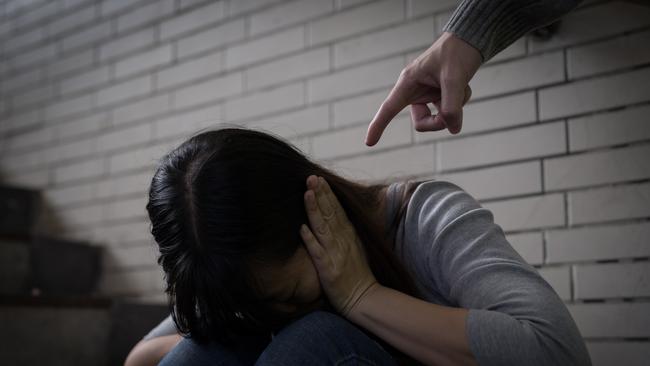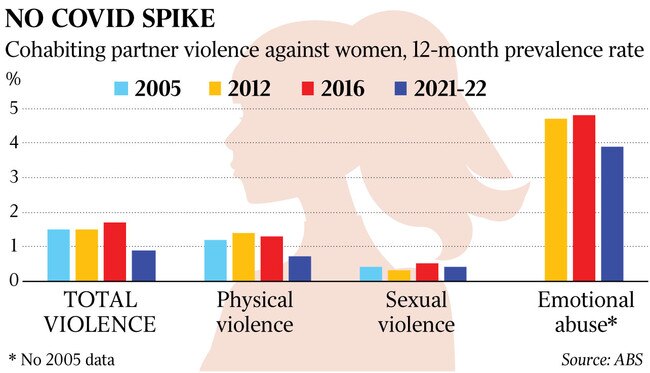Partner violence and emotional abuse fell during Covid: ABS
Fears lockdowns would lead to a spike in violence against women cooped up with their partners have proven unfounded.

Fears the Covid lockdowns would lead to a spike in violence against women cooped up with their partners have proven unfounded, with new data showing declining rates of both violence and emotional abuse by cohabiting partners.
There were also significant differences between the two most Covid-affected states, with Victoria showing a drop in the rate of sexual violence between 2016 and 2021-22, while NSW recorded an increase.
But the overall incidence of physical and sexual violence, abuse and harassment of women remains disturbingly high, with more than one in five women in Australia, 2.2 million, having experienced sexual violence since the age of 15, and one in three physical violence. One in five had been stalked.
The Australian Bureau of Statistics’ Personal Safety Survey 2021-22 report also finds two in five men, four million, had experienced physical violence after the age of 15, and one in sixteen sexual violence.
But while the perpetrator of physical violence against men was more likely to be a stranger than known to them, for women it was the reverse.
The ABS surveyed 12,000 people between March 2021 and May 2022, asking for their experiences of sexual and physical violence, stalking, emotional abuse, and for the first time, economic abuse.
“One in six women and one in eighteen men have experienced physical or sexual violence by a cohabiting partner,” ABS head of crime and justice statistics Michelle Ducat said. “(And) one in four women and one in seven men experienced emotional abuse by a cohabiting partner.”
Ms Ducat said economic abuse, which occurs when a partner controls or restricts a person’s access to economic resources, including such things as access to study or work, was experienced at least once by one in six women and one in thirteen men.
But in data that ran counter to expectations, the prevalence rates of violence experienced during the Covid lockdown were no higher than those reported five years earlier, and in some cases were lower.
“We saw similar rates of physical violence and sexual violence in 2021-22 when compared with 2016,” Ms Ducat said.
When asked if they had experienced sexual harassment in the last 12 months, the proportion who said yes declined for both women (from 17 per cent in 2016 to 13 per cent in 2021-22) and men (from 9.3 per cent to 4.5 per cent).
The rate of cohabiting partner emotional abuse also declined over the same period for both women (from 4.8 per cent to 3.9 per cent) and men (from 4.2 per cent to 2.5 per cent), as did the rate of cohabiting partner violence for women (from 1.7 per cent to 0.9 per cent).
In NSW, two-year prevalence rates (whether someone has had an incident in the previous two years) of sexual violence increased from 2.3 per cent in 2016 to 3.5 per cent in 2021-22, the data reveals. In Victoria the proportion fell from 3.7 per cent to 2.1 per cent.
Victoria also saw significant reductions in prevalence of partner violence between 2016 and 2021-22, down from 2.4 per cent to 1.4 per cent, and partner emotional abuse, from 6.8 per cent to 4.9 per cent.
Kristin Diemer, Associate Professor of Sociology at Melbourne University and a specialist in family and domestic violence, said the data “does run against expectations of a rise in partner violence during the Covid lockdowns, and we need to drill in deeper to work out what it means.

“It may be that measures introduced by governments during Covid on income support and job protection turned out to be protective measures in terms of family violence, with financial stress and job stress often triggers for violence,” Associate Professor Diemer said.
“It also may be that the data shows a real decrease in prevalence after a concerted effort by state and federal governments to reduce family and domestic violence. It is interesting to note that rates of violence have decreased substantially in Victoria, perhaps reflecting leadership on family violence program funding and policy effort following the royal commission on the topic.”
Padma Raman, chief executive of Australia’s National Research Organisation for Women’s Safety, said any reduction in prevalence rates was “a positive sign”.
“We are pleasantly surprised that there was a significant decrease in sexual harassment and a notable decrease in intimate partner violence. However, given what we know about COVID-19 and the stressors people experience, more needs to be done to analyse these findings.”
If you or anyone you know is in need or crisis, please call the National Sexual Assault, Domestic and Family Violence Counselling Service on 1800RESPECT (1800 737 732) or Lifeline (131 114).



